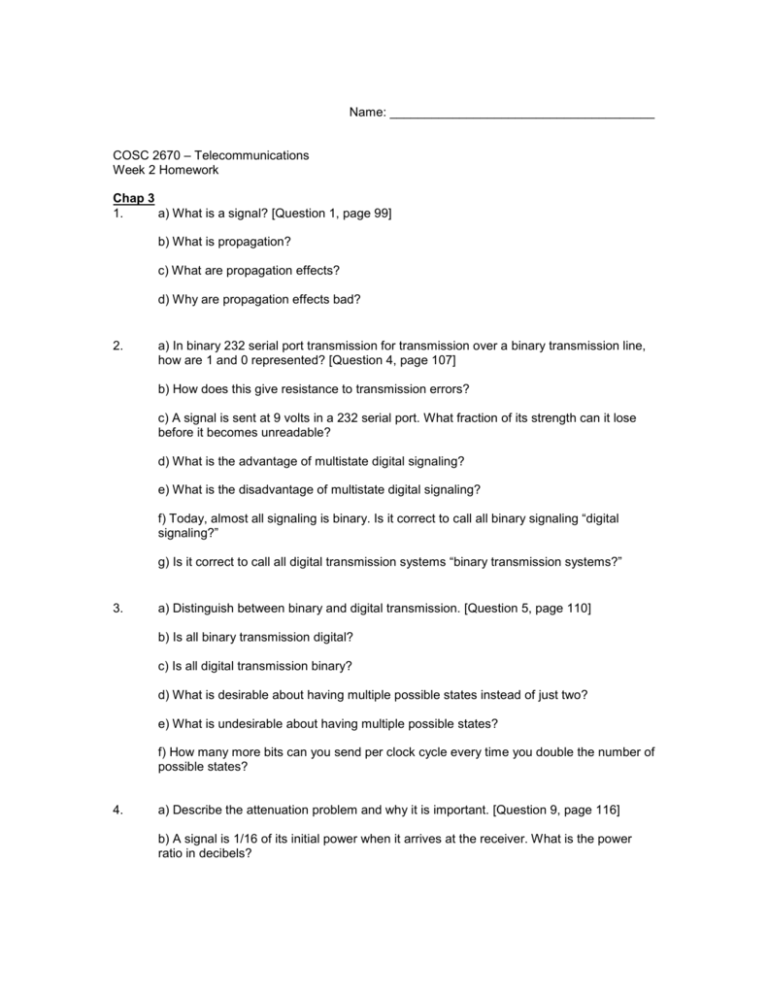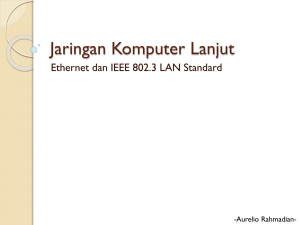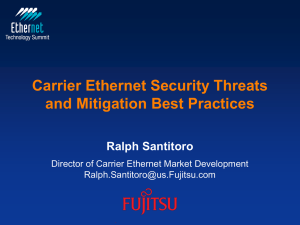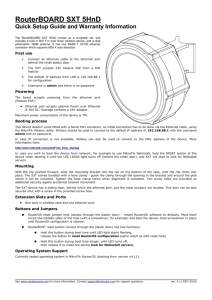Name
advertisement

Name: ______________________________________ COSC 2670 – Telecommunications Week 2 Homework Chap 3 1. a) What is a signal? [Question 1, page 99] b) What is propagation? c) What are propagation effects? d) Why are propagation effects bad? 2. a) In binary 232 serial port transmission for transmission over a binary transmission line, how are 1 and 0 represented? [Question 4, page 107] b) How does this give resistance to transmission errors? c) A signal is sent at 9 volts in a 232 serial port. What fraction of its strength can it lose before it becomes unreadable? d) What is the advantage of multistate digital signaling? e) What is the disadvantage of multistate digital signaling? f) Today, almost all signaling is binary. Is it correct to call all binary signaling “digital signaling?” g) Is it correct to call all digital transmission systems “binary transmission systems?” 3. a) Distinguish between binary and digital transmission. [Question 5, page 110] b) Is all binary transmission digital? c) Is all digital transmission binary? d) What is desirable about having multiple possible states instead of just two? e) What is undesirable about having multiple possible states? f) How many more bits can you send per clock cycle every time you double the number of possible states? 4. a) Describe the attenuation problem and why it is important. [Question 9, page 116] b) A signal is 1/16 of its initial power when it arrives at the receiver. What is the power ratio in decibels? c) A signal is 1/100 of its initial value when it reaches the receiver. What is this power ratio in decibels? d) Describe the noise problem. e) As a signal propagates down a UTP cord, the noise level is constant. Will greater propagation distance result in fewer noise errors, the same number of noise errors, or more noise errors? Explain. 5. a) Distinguish between electromagnetic interference (EMI), crosstalk interference, and terminal crosstalk interference. [Question 11, page 118] b) How is EMI controlled? c) How is terminal crosstalk interference controlled in general? Explain. d) Does this precaution eliminate terminal crosstalk interference? 6. a) Distinguish between serial and parallel transmission. [Question 12, page 119] b) What is the main benefit of parallel transmission? c) In parallel transmission, how many pairs (or single wires and ground wires) are used in each direction? d) Is serial or parallel transmission more widely used today? 7. a) How does optical fiber signaling represent 1s and 0s? [Question 14, page 122] b) What is the main benefit of optical fiber compared with UTP today? c) Which costs less to buy and install—UTP or optical fiber? 8. a) Distinguish between omnidirectional and dish antennas in terms of operation. [Question 20, page 131] b) Under what circumstances would you use an omnidirectional antenna? c) Under what circumstances would you use a dish antenna? d) What type of antenna normally is used in WLANs? Why? 9. a) Which offers more reliable transmission characteristics—UTP or radio transmission? [Question 21, page 133] b) Which attenuate more rapidly with distance—signals sent though wired media or radio signals? c) If the signal strength from an omnidirectional radio source is 8 milliwatts (mW) at 30 meters, how strong will it be at 120 meters, ignoring absorptive attenuation? Show your work. c1) List the two types of interference that are encountered in wireless transmission. d) How are shadow zones (dead spots) created? e) Why is multipath interference very sensitive to location? f) What is the most serious propagation problem in WLANs? g) List some sources of EMI. h) What propagation problems become worse as frequency increases? 10. a) What is a network topology? [Question 22, page 135] b) At what layer do we find topologies? c) List the major network topologies, and give the defining characteristics for each one. Present each topology in a separate paragraph. d) What technology is associated with each topology? Chap 4 1. a) What is the dominant LAN technology today? [Question 1, page 146] b) Why did it become dominant? 2. a) What is link aggregation (trunking or bonding)? [Question 4, page 152] b) Why may link aggregation be more desirable than installing a single faster link? c) Why may link aggregation not be desirable if you will need several aggregated links to meet capacity requirements? 3. a) Distinguish between the MAC and LLC layers. [Question 6, page 156] b) Does Ethernet have multiple physical layer standards? c) Does Ethernet have multiple MAC layer standards? d) What is the name of Ethernet’s single MAC standard? 4. a) What is the purpose of the preamble and start of frame delimiter fields? [Question 7, page 158] b) Why are Ethernet addresses called MAC addresses or physical addresses? c) What are the steps in converting 48-bit MAC addresses into hex notation? d) The length field gives the length of what? e) What are the two components of the Ethernet data field? f) What is the purpose of the LLC subheader? g) What type of packet is usually carried in the data field? h) What is the maximum length of the data field? i) Who adds the PAD field—the sender or the receiver? j) Is there a minimum length for the data field? k) If the data field is 40 octets long, how long a PAD field must the sender add? l) If the data field is 400 octets long, how long a PAD field must the sender add? m) What is the purpose of the frame check sequence field? n) What happens if the receiver detects an error in a frame? o) Convert 11000010 to hex. 5. a) How are switches in an Ethernet LAN organized? [Question 9, page 161] b) Because of this organization, how many possible paths can there be between any two stations? c) In Figure 4-10, what is the single possible path between Client PC 1 and Server Y? d) Between Client PC 1 and Server X? 6. a) Why is having a single possible path between any two stations in an Ethernet network dangerous? [Question 12, page 163] b) What is a single point of failure? c) What standard allows redundancy in Ethernet networks? d) Is it easy or difficult to create backup links effectively in 802.1w RSTP? 7. a) What is a VLAN? [Question 13, page 166] b) What two benefits do VLANs address bring? c) How do VLANs bring security? d) What two fields does the 802.1Q standard add to Ethernet frames? e) What does the Tag Protocol ID tell a receiving switch or NIC? f) What information does the tag control information field tell the switch or receiver? 8. a) What Ethernet technology broadcasts each arriving bit out through all other ports? [Question 15, page 170] b) What is media access control, and why must NICs that work with hubs use it? c) When NICs work with hubs, what media access control method do they use? d) How does CSMA/CD work? e) Why are hubs undesirable? 9. a) Which is likely to have less latency—a cut-through switch or a store-and-forward switch? Explain. [Question 18, page 172] b) What is the advantage of the other mode of operation? c) Is determining which mode of operation a switch uses a major purchasing issue today? 10. a) What threat does 802.1X address? [Question 21, page 179] b) How does the standard address the threat? c) In 802.1X, what device is the NAS? d) What are the benefits of using a central authentication server instead of having the individual NASs do all authentication work? e) What threat does 802.1AE address? f) How does the standard attempt to thwart such attacks? g) Did the working group that creates Ethernet standards create the 802.1X and 802.1AE standards? Explain.






